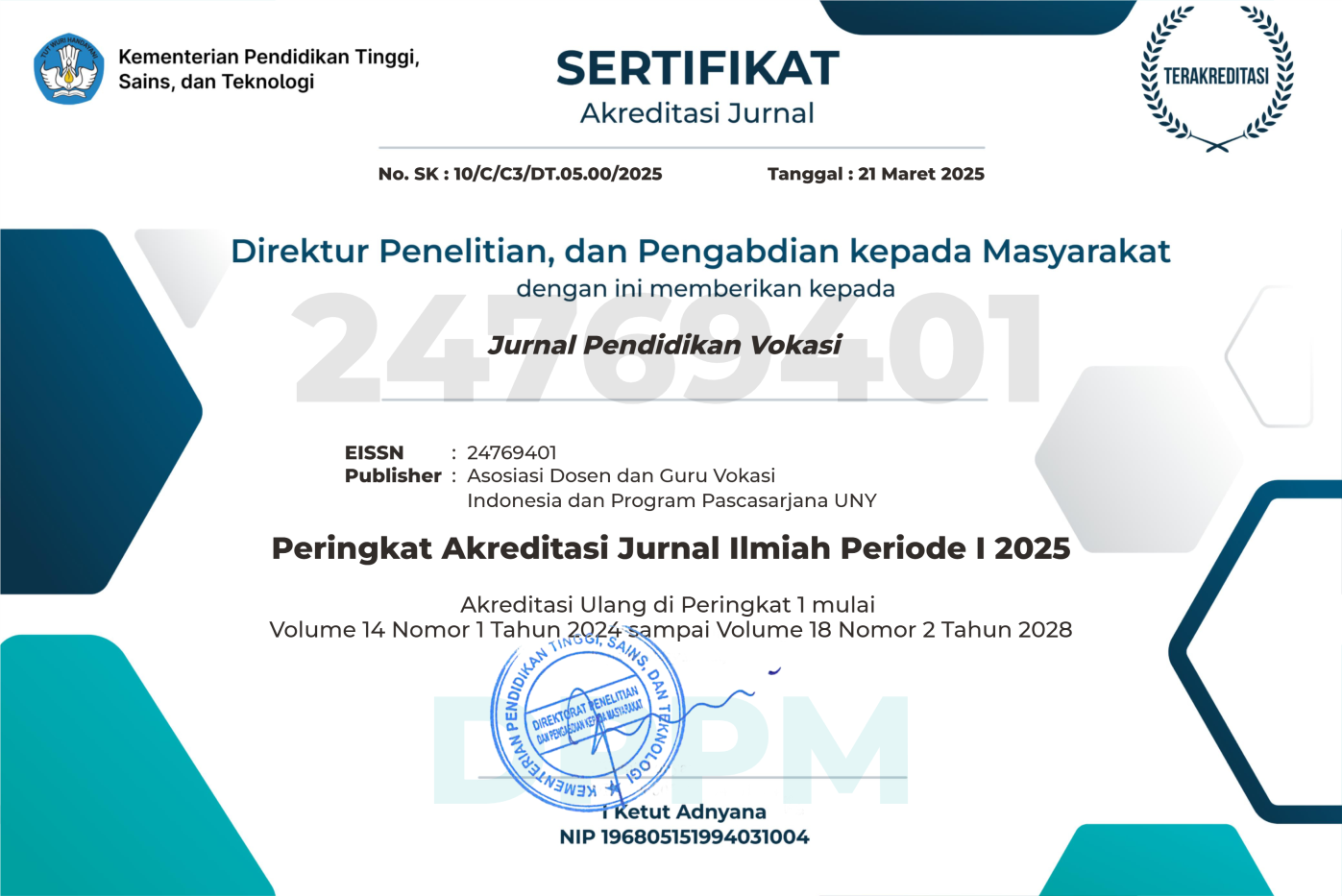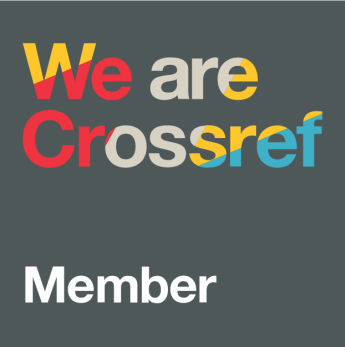The effect of online learning quality on vocational students' learning achievement during the Covid-19 Pandemic
DOI:
https://doi.org/10.21831/jpv.v12i2.47570Keywords:
Covid-19 Pandemic, learning achievement, online learning quality, vocational studentsAbstract
References
Acosta, M. L., Sisley, A., Ross, J., Brailsford, I., Bhargava, A., Jacobs, R., & Anstice, N. (2018). Student acceptance of e-learning methods in the laboratory class in Optometry. PLoS ONE, 13(12), 1–15. https://doi.org/10.1371/journal.pone.0209004
Al-Fraihat, D., Joy, M., & Sinclair, J. (2020). Evaluating e-learning systems success: An empirical study. Computers in Human Behavior, 102, 67–86. https://doi.org/10.1016/j.chb.2019.08.004
Anas, M. (2021). Impact of pandemic COVID-19 on Local Government's financial performance in Indonesia. Journal of Southwest Jiaotong University, 56(3), 196–206. https://doi.org/10.35741/issn.0258-2724.56.3.16
Astuti, P. B., & Mahardhika, A. S. (2020). COVID-19: How does it impact to the Indonesian economy? Jurnal Inovasi Ekonomi, 5(02), 85–92. https://doi.org/10.22219/jiko.v5i02.11751
Ayu, M. (2020). Online learning: Leading e-learning at higher education. The Journal of English Literacy Education: The Teaching and Learning of English As a Foreign Language, 7(1), 47–54. https://doi.org/10.36706/jele.v7i1.11515
Aziz, R. C., Hashim, N. A. A. N., Omar, R. N. R., Yusoff, A. M., Muhammad, N. H., Simpong, D. B., Abdullah, T., Zainuddin, S. A., & Safri, F. H. M. (2019). Teaching and learning in higher education: E-learning as a tool. International Journal of Innovative Technology and Exploring Engineering (IJITEE), 9(1), 458–463. https://doi.org/10.35940/ijitee.A4188.119119
Budiyanti, N., Aziz, A. A., Palah, P., & Mansyur, A. S. (2020). The formulation of the goal of insan kamil as a basis for the development of Islamic Education curriculum. IJECA (International Journal of Education and Curriculum Application), 3(2), 81–90. https://doi.org/10.31764/ijeca.v3i2.2252
Bylieva, D., Lobatyuk, V., Safonova, A., & Rubtsova, A. (2019). Correlation between the Practical Aspect of the Course and the e-learning progress. Education Sciences, 9(3), 1–14. https://doi.org/10.3390/educsci9030167
Denis, D. J. (2018). SPSS data analysis for univariate, bivariate, and multivariate statistics. John Wiley & Sons.
Djalante, R., Lassa, J., Setiamarga, D., Sudjatma, A., Indrawan, M., Haryanto, B., Mahfud, C., Sinapoy, M. S., Djalante, S., & Rafliana, I. (2020). Review and analysis of current responses to COVID-19 in Indonesia: Period of January to March 2020. Progress in Disaster Science, 6, 100091. https://doi.org/10.1016/j.pdisas.2020.100091
Dufrene, C., & Young, A. (2014). Successful debriefing"”Best methods to achieve positive learning outcomes: A literature review. Nurse Education Today, 34(3), 372–376. https://doi.org/10.1016/j.nedt.2013.06.026
Fajri, Z., Baharun, H., Muali, C., Farida, L., & Wahyuningtiyas, Y. (2021). Student's learning motivation and interest; The effectiveness of online learning during COVID-19 pandemic. Journal of Physics: Conference Series, 1899(1), 12178. https://doi.org/10.1088/1742-6596/1899/1/012178/meta
Gherheș, V., Stoian, C. E., Fărcașiu, M. A., & Stanici, M. (2021). E-learning vs. face-to-face learning: Analyzing students' preferences and behaviors. Sustainability, 13(8), 4381. https://doi.org/10.3390/su13084381
Gopal, R., Singh, V., & Aggarwal, A. (2021). Impact of online classes on the satisfaction and performance of students during the pandemic period of COVID 19. Education and Information Technologies, 26(6), 6923–6947. https://doi.org/10.1007/s10639-021-10523-1
Hadullo, K., Oboko, R., & Omwenga, E. (2017). A model for evaluating e-learning systems quality in higher education in developing countries. International Journal of Education and Development Using ICT, 13(2), 185–204. https://www.learntechlib.org/p/180643/
Hang, N. T. (2021). Digital education to improve the quality of human resources implementing digital transformation in the context of industrial revolution 4.0. Revista Gestí£o Inovaí§í£o e Tecnologias, 11(3), 311–323. https://doi.org/10.47059/revistageintec.v11i3.1940
Ippakayala, V. K., & El-Ocla, H. (2017). OLMS: Online Learning Management System for e-learning. World Journal on Educational Technology: Current Issues, 9(3), 130–138. https://doi.org/10.18844/wjet.v6i3.1973
Kristanto, A. (2017). The development of instructional materials e-learning based on blended learning. International Education Studies, 10(7), 10–17. https://doi.org/10.5539/ies.v10n7p10
Leindarita, B. (2021). Influence of communication and teaching lecturers competencies towards students online learning satisfaction in the time of Covid-19. International Conference on Educational Sciences and Teacher Profession (ICETeP 2020), 98–102. https://doi.org/10.2991/assehr.k.210227.016
Linh, L. T. N., Lam, N. T., & Ngoc, N. H. (2021). Using e-learning platforms in online classes: A survey on tertiary English teachers' perceptions. AsiaCALL Online Journal, 12(5), 34–53. https://doi.org/10.11251/acoj.12.05.004
Mahyoob, M. (2021). Online learning effectiveness during the COVID-19 pandemic: A case study of Saudi universities. International Journal of Information and Communication Technology Education (IJICTE), 17(4), 1–14. https://doi.org/10.4018/IJICTE.20211001.oa7
Mardiah, H. (2020). The use of e-learning to teach English in the time of the Covid-19 pandemic. English Teaching and Linguistics Journal (ETLiJ), 1(2), 45–55. https://doi.org/10.30596%2Fetlij.v1i2.4894
Medio, C. De, Limongelli, C., Sciarrone, F., & Temperini, M. (2020). MoodleREC: A recommendation system for creating courses using the moodle e-learning platform. Computers in Human Behavior, 104, 106168. https://doi.org/10.1016/j.chb.2019.106168
Miedany, Y. El. (2019). E-learning, adaptive learning and mobile learning. In Rheumatology teaching: The art and science of medical education (pp. 235–258). Springer.
Mpungose, C. B. (2020). Emergent transition from face-to-face to online learning in a South African University in the context of the Coronavirus pandemic. Humanities and Social Sciences Communications, 7(1), 1–9. https://doi.org/10.1057/s41599-020-00603-x
Nambiar, D. (2020). The impact of online learning during COVID-19: Students' and teachers' perspective. The International Journal of Indian Psychology, 8(2), 783–793. https://doi.org/10.25215/0802.094
Nishimura, Y., Ochi, K., Tokumasu, K., Obika, M., Hagiya, H., Kataoka, H., & Otsuka, F. (2021). Impact of the COVID-19 pandemic on the psychological distress of medical students in Japan: Cross-sectional survey study. Journal of Medical Internet Research, 23(2), e25232. https://doi.org/10.2196/25232
Olivia, S., Gibson, J., & Nasrudin, R. an. (2020). Indonesia in the time of Covid-19. Bulletin of Indonesian Economic Studies, 56(2), 143–174. https://doi.org/10.1080/00074918.2020.1798581
Pham, L., Limbu, Y. B., Bui, T. K., Nguyen, H. T., & Pham, H. T. (2019). Does e-learning service quality influence e-learning student satisfaction and loyalty? Evidence from Vietnam. International Journal of Educational Technology in Higher Education, 16(1), 1–26. https://doi.org/10.1186/s41239-019-0136-3
Prasetya, T. A., & Harjanto, C. T. (2020). Pengaruh mutu pembelajaran online dan tingkat kepuasan mahasiswa terhadap hasil belajar saat pandemi Covid19. Jurnal Pendidikan Teknologi Dan Kejuruan, 17(2), 188–197. https://doi.org/10.23887/jptk-undiksha.v17i2.25286
Putri, R. H., Lesmono, A. D., & Aristya, P. D. (2017). Pengaruh model discovery learning terhadap motivasi belajar dan hasil belajar fisika siswa MAN Bondowoso. Jurnal Pembelajaran Fisika, 6(2), 173–180. https://doi.org/10.19184/jpf.v6i2.5017
Rapanta, C., Botturi, L., Goodyear, P., Guí rdia, L., & Koole, M. (2020). Online university teaching during and after the Covid-19 crisis: Refocusing teacher presence and learning activity. Postdigital Science and Education, 2(3), 923–945. https://doi.org/10.1007/s42438-020-00155-y
Razinkina, E., Pankova, L., Trostinskaya, I., Pozdeeva, E., Evseeva, L., & Tanova, A. (2018). Student satisfaction as an element of education quality monitoring in innovative higher education institution. E3S Web of Conferences, 33, 03043. https://doi.org/10.1051/e3sconf/20183303043
Shaaban, S. S. A. (2020). TEFL professors'e-learning experiences during the COVID 19 pandemic. European Journal of Foreign Language Teaching, 5(1), 82–97. https://doi.org/10.46827/ejfl.v5i1.3202
Shirish, A., Chandra, S., & Srivastava, S. C. (2021). Switching to online learning during COVID-19: Theorizing the role of IT mindfulness and techno eustress for facilitating productivity and creativity in student learning. International Journal of Information Management, 61, 102394. https://doi.org/10.1016/j.ijinfomgt.2021.102394
Situmorang, E., Hutasuhut, S., & Maipita, I. (2019). The effect of e-learning, student facilitator and explaining model learning and self-regulated learning on 11th grade students learning outcomes of economic subject in Senior High School 1 Perbaungan School Year 2019/2020. Budapest International Research and Critics in Linguistics and Education Journal (Birle Journal), 2(4), 461–469. https://doi.org/10.33258/birle.v2i4.537
Sí¶nmez, V. (2017). Association of cognitive, affective, psychomotor and intuitive domains in education, Sí¶nmez Model. Universal Journal of Educational Research, 5(3), 347–356. https://doi.org/10.13189/ujer.2017.050307
Sulisworo, D. (2016). The contribution of the education system quality to improve the nation's competitiveness of Indonesia. Journal of Education and Learning, 10(2), 127–138. https://doi.org/10.11591/edulearn.v10i2.3468
Syauqi, K., Munadi, S., & Triyono, M. B. (2020). Students' perceptions in vocational education on online learning during the covid-19 pandemic. International Journal of Evaluation and Research in Education (IJERE), 9(4), 881–886. https://doi.org/10.11591/ijere.v9i4.20766
Talosa, A. D., Javier, B. S., & Dirain, E. L. (2021). The flexible-learning journey: phenomenological investigation of self-efficacy influencing factors among higher education students. Linguistics and Culture Review, 5(S3), 422–434. https://doi.org/10.21744/lingcure.v5nS3.1590
Xiong, J., Tang, Z., Zhu, Y., Xu, K., Yin, Y., & Xi, Y. (2021). Change of consumption behaviours in the pandemic of COVID-19: Examining residents' consumption expenditure and driving determinants. International Journal of Environmental Research and Public Health, 18(17), 9209. https://doi.org/10.3390/ijerph18179209
Downloads
Published
How to Cite
Issue
Section
Citation Check
License
The authors submitting a manuscript to this journal agree that, if accepted for publication, copyright publishing of the submission shall be assigned to Jurnal Pendidikan Vokasi. However, even though the journal asks for a copyright transfer, the authors retain (or are granted back) significant scholarly rights.
The copyright transfer agreement form can be downloaded here: [JPV Copyright Transfer Agreement Form]
The copyright form should be signed originally and sent to the Editorial Office through email to jpvokasi@uny.ac.id
Jurnal Pendidikan Vokasi by http://journal.uny.ac.id/index.php/jpv is licensed under a Creative Commons Attribution-ShareAlike 4.0 International License.













